Gerald Hirigoyen - Pintxos: Small Plates in the Basque Tradition
Here you can read online Gerald Hirigoyen - Pintxos: Small Plates in the Basque Tradition full text of the book (entire story) in english for free. Download pdf and epub, get meaning, cover and reviews about this ebook. year: 2009, publisher: Ten Speed Press, genre: Home and family. Description of the work, (preface) as well as reviews are available. Best literature library LitArk.com created for fans of good reading and offers a wide selection of genres:
Romance novel
Science fiction
Adventure
Detective
Science
History
Home and family
Prose
Art
Politics
Computer
Non-fiction
Religion
Business
Children
Humor
Choose a favorite category and find really read worthwhile books. Enjoy immersion in the world of imagination, feel the emotions of the characters or learn something new for yourself, make an fascinating discovery.

- Book:Pintxos: Small Plates in the Basque Tradition
- Author:
- Publisher:Ten Speed Press
- Genre:
- Year:2009
- Rating:5 / 5
- Favourites:Add to favourites
- Your mark:
Pintxos: Small Plates in the Basque Tradition: summary, description and annotation
We offer to read an annotation, description, summary or preface (depends on what the author of the book "Pintxos: Small Plates in the Basque Tradition" wrote himself). If you haven't found the necessary information about the book — write in the comments, we will try to find it.
Acclaimed chef Gerald Hirigoyens sophisticated and delectable small plates, served at his restaurants, Bocadillos and Piperade, set the standard for tapas in San Francisco. This book features 75 distinctive California-inflected versions of Spanish tapas and French Basque dishes (including Salt Cod with Piperade, Roasted Beets with Moroccan Spices, and Oxtail Empanadas with Spicy Mango Dip) specially written for the home cook. Conveniently organized by type of dish--grilled, soups, braises, skewers and toasts, sandwiches, bean dishes, and fried foods--and illustrated with the exemplary photography of James Beard award-winning photographer Maren Caruso, PINTXOS is all you need to host an authentic and stylish tapas party at home.
[Bocadillos is] the most captivating and authentic-feeling Spanish tapas-style restaurant in the city. --Michael Bauer, San Francisco ChronicleReviews[A] tasty and broad array of small plates that will tantalize and satisfy.Publishers Weekly
Gerald Hirigoyen: author's other books
Who wrote Pintxos: Small Plates in the Basque Tradition? Find out the surname, the name of the author of the book and a list of all author's works by series.














